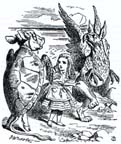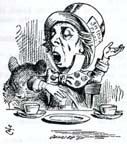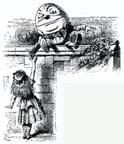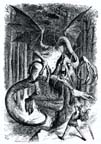

Despite his large number of contributions to Punch and elsewhere, John Tenniel's reputation as an illustrator and cartoonist is indelibly tied (at least as far as the general public is concerned) to his participation in the Alice books of Charles Dodgson. Here Tenniel found a text fully conducive to the nature of his genius, and there can be no doubt that his illustrations played an important role in insuring both books' immediate and continued success. Indeed, one can hardly think of the Mock Turtle, the Mad Hatter, Tweedledee and Tweedledum, and many other of Dodgson's characters, without Tenniel's illustrations immediately springing to mind. But, Dodgson and Tenniel being very different men, the collaboration was perhaps an unlikely one, and although undoubtedly successful, both seem to have come away from it to some extent dissatisfied. As Percy Muir notes in his Victorian Illustrated Books, Tenniel's refusal to undertake any more work with Dodgson is very revealing, and then on the other side, "of the 92 illustrations to the two books Dodgson approved of only one — 'Humpty Dumpty'" (109).

Taking that as a hint, let us turn now to the illustration of Humpty Dumpty in Through the Looking-Glass, so as to examine how it relates to the text accompanying it. Dodgson writes, "He [Humpty Dumpty] grinned almost from ear to ear, as he leant forwards (and as nearly as possible fell off the wall in doing so) and offered Alice his hand. She watched him a little anxiously as she took it" (160-61). In the related image, we see Alice from behind, depicted as a young girl, reaching up to shake hands with the precariously situated Humpty Dumpty. The idea of Humpty Dumpty being an egg is of course not a new one, but Tenniel's realization of him is a marvel of the comic grotesque, with his sour smile and geometrical cravat, which becomes an object of such confusion for Alice. Here, the illustration's subject itself finds a kind of fortunate balance, surer than that that of Humpty Dumpty, by being at once fanciful and yet precisely conceivable in visual terms, which no doubt played a part in Dodgson's admiring it so singularly. Impressive though the image is, there was hardly space for Tenniel to invent any significant material beyond that which has been already given in the text; his work is that of a pure illustrator.

Tenniel's illustration of "Jabberwocky" provides an interesting point of comparison, in that here the relationship between text and image is far less stable. As Michael Holquist discusses, Dodgson's nonsense poetry represents "the attempt to create an immaculate fiction, a fiction that resists the attempts of readers, and especially those readers who write criticism, to turn it into an allegory, a system equatable with already existing systems in the non-fictive world" (390). It is obviously impossible to illustrate words faithfully that lack identifiable referents. Certainly, there are elements in the poem which find powerful realization in Tenniel's image (the "eyes of flame," "the jaws that bite, the claws that catch"), but where are the textual antecedents for the antennae, the wings, or the beast's wonderfully ironic vest? Tenniel's whole scheme is rather more directly reminiscent of the Siegfried-dragon-slayer motif than is strictly warranted by Dodgson's language, and thus to some extent functions as an interpretative commentary, or even, an allegorization of the poem: precisely the tendency which is diametrically opposed to that noted by Holquist above.
I would argue, however, that these two scenes represent something of extremes out of a range of possibilities which must have been both congenial to Tenniel's abilities, and at least, acceptable to Dodgson. Surely it is a part of every illustrator's task to consider to what degree departure from the literal meaning of a text is acceptable; and indeed, one of the reasons why Tenniel's illustrations function so well is precisely because he is willing on so many occasions to take Dodgson's words at face value. That's not to diminish Tenniel's creative abilities, however, and in the end, it is the sheer vitality of his re-imagining, indeed, of his re-presentation of Dodgson's Alice, which continues to both startle and amuse.
Questions
Consider Tenniel's Alice illustrations in relation to his political cartoons. What differences of tone or technique do you see there? Or can you find political content in his Alice illustrations?
Continuing along these lines, was Tenneil necessarily in possession of greater creative freedom when the text he was illustrating was his own?
Are there any elements in Tenneil's illustrations of Alice which seem to anticipate the works of Aubrey Beardsley and other artists of the fin-de-siéle?
Discuss Humpty Dumpty's explication of "Jabberwocky," beginning on page 164 of the Norton edition. What can this passage tell us about Dodgson's own view of poetry and language?
Related Material
Works Cited
Dodgson, Charles (a.k.a. Lewis Carroll). Alice in Wonderland. Ed. Donald J. Gray. New York: W. W. Norton, 1992.
Holquist, Michael. "What is a Boojum? Nonsense and Modernism." Yale French Studies 43 (1969): 145-64. (rpt. in Dodgson 1992: 388-398)
Muir, Percy. Victorian Illustrated Books. New York: Praeger Publishers, 1971.
Last modified 25 October 2004